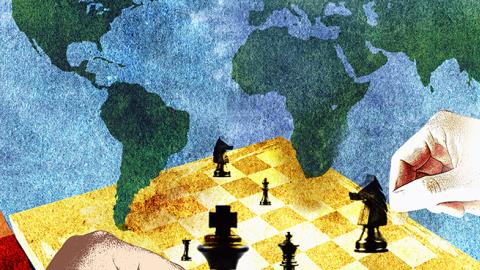President Trump inherited a world in crisis, with the Pax Americana challenged in Asia, the Middle East, Europe and the Caribbean. Today the White House has clear priorities—but questions about temperament and competence persist.
Think back 10 months to Inauguration Day. North Korea was regularly testing and improving its missiles and nuclear weapons, well on its way to threatening the American mainland. China was intensifying its multifaceted challenge to the Asian status quo. Iran’s expansionism threatened to plunge the Middle East into chaos, and the regime had outmaneuvered an Obama administration that was desperate for a nuclear deal. Russia’s annexation of Crimea and support for breakaway forces in eastern Ukraine presented legal and geopolitical challenges to the post-Cold War order. Venezuela’s progressive degradation threatened to destabilize Latin America, a region of direct interest to the U.S.
Remember, too, President Trump’s skepticism of global engagement. He came into office convinced that American interests were being undermined by the multilateral trading system, as established by the George H.W. Bush and Bill Clinton administrations. He disdained the process enshrined in the 2016 Paris climate accord.
If all this weren’t enough, the incoming team knew that the American public was increasingly skeptical of large overseas commitments—whether to diplomacy, foreign aid or war. And the journalistic and foreign-policy establishments viscerally opposed Mr. Trump on personal and political grounds.
Talleyrand, Metternich, Bismarck and Kissinger, working together, would have had a difficult time managing a portfolio this large, urgent and unwieldy. The Trump administration has struggled visibly to develop a coherent approach. Yet as the president’s first year nears its conclusion, some order has begun to emerge, and at least the outlines of a Trump global policy now seem clear.
The first task was to set priorities, and it is obvious that the White House is putting Asia and the Middle East above other regions and issues. The crises in Ukraine and Venezuela are on the back burner. So are climate and trade policy, though the president’s tweets sometimes disguise this reality.
When addressing its priorities, the Trump administration has chosen an activist approach, tightening relations with traditional allies to restore regional orders under threat. This means checking Iran by working closely with the untested new Saudi leadership, as well as Egypt, the United Arab Emirates and Israel.
This anti-Iran phase is beginning in earnest now that the Trump administration’s original goal of destroying Islamic State’s so-called caliphate has been largely achieved. The White House also hopes the new constellation of forces will allow progress on another goal: containing and maybe even resolving the Israeli-Palestinian dispute.
In Asia the administration, working closely with Japan, is trying to assemble and strengthen a coalition to counterbalance China—while simultaneously seeking Chinese cooperation in tightening the screws on North Korea. The White House hopes that offering Beijing a smooth trade and political relationship will induce it to provide real help with the North Korea problem, even as the U.S. works to persuade the North Koreans that the risks of conflict are real.
Mr. Trump’s foreign policy has so far turned out to be more conventional than his rhetoric and style would suggest. Working with America’s traditional allies in Asia and the Middle East against those regions’ revisionist powers hardly amounts to a strategic revolution.
But if Mr. Trump’s current goals are conventional, the state of the world is not. He may well fail. The challenges are large, the learning curve is steep, and the terrain is unforgiving. Allies and adversaries are watching the Republican Party’s disarray on issues like health care, assessing the prospects of a Democratic wave in 2018, and paying close attention to the progress of the Mueller investigation. Mr. Trump’s foreign policy, like his presidency overall, is a gamble whose outcome the president cannot fully control.
For now Mr. Trump is performing a high-wire act, juggling his way across the Indo-Pak region even as his administration pursues ambitious goals in the Middle East. Some of the world’s most powerful countries hope that he fails, and they will do what they can to trip him up. Americans, regardless of party or their personal sentiments about Mr. Trump, should wish him success overseas. The consequences of failure could be extreme.















